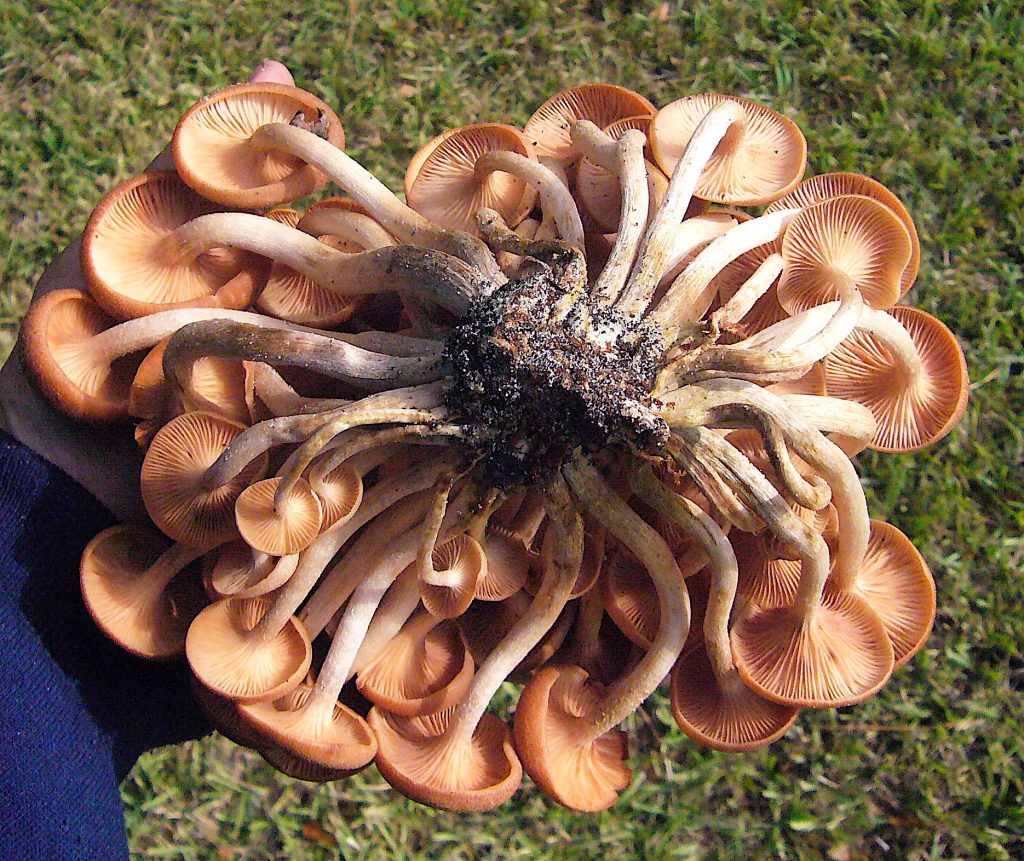
These prime Ringless Honey Mushrooms are cespitose, all growing out of one spot. Photo by Green Deane
Mother Nature has her own schedule: Persimmons are late this year, Ringless Honey Mushrooms are early, and Golden Rain Trees are coloring sidewalks.
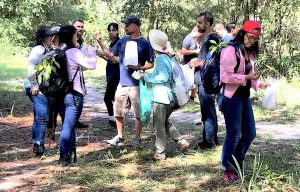
OMG! The Orlando Mushroom Group has a successful mushroom hunt has week with 20 people finding a wide variety of species.
Ringless Honey Mushrooms, Armillaria tabescens aka Desarmillaria tabescens) usually flush locally between the first and second week of November. The further north you are the sooner and the further south later. In the Carolinas I see them in late August, in West Palm Beach December. I actually saw some five weeks ago in east Orlando but that was an isolated sighting. I’ve seen, however, several clumps of them in the last few days. Once the season starts they are around for two or three weeks. Ringless Honey Mushrooms are prolific. It is easy in a season to harvest a 100 pounds of them or more. They are among the most easy of mushrooms to identity. What I usually do is dry the cleanest then wash and eat the rest. As for edibility opinions range from “choice” to not edible. They have a “meaty” texture meaning you can cook them a lot and they keep their firmness. To me they have a flavor (perhaps aroma) that reminds me of maple syrup. I do know two people who can’t eat them even if they cook them twice. The mushroom gives them digestive issues. If the weather is right Ringless Honey Mushrooms also can have a small flush locally around April. That is hit or miss whereas the fall flush is assured. Technically they can grow all year and I once saw them on a Banyan in West Palm Beach in July. I have an article on them here and a video here.
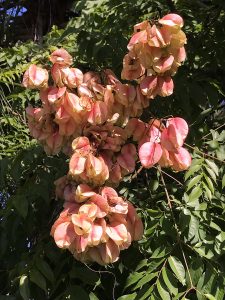
Seed pods of the Golden Rain Tree. Photo by Green Deane
And now the Golden Rain Tree… of all the species I have written about over the years this is one I have perhaps the least personal experience with. I have a good reason: I always recognize it at the wrong time of the year when it’s dropping yellow petals in the fall. It is the tree’s springtime boiled shoots that are the most edible part of this species. In the spring, however, the tree is a rather drab Elm- Chinaberry-lookalike. This time of year tree also produces pink boxy seed pods. Usually inside one finds two or four black seeds that are reportedly edible. The problem is they have unrefined erucic acid (oil) which is the same irritating oil in unprocessed rape seed oil which when refined is called Canola. If you have an undisciplined memory like mind the mentioning of erucic acid makes you think of a movie you did not see: Lorenzo’s Oil. The oil, now made from olive oil and erucic aicd, is used to treat ALD, adrenoleukodystrophy. The 1992 movie was based on the true story of parents looking for a treatment for their son. ALD is a genetic disease that causes a metabolic error that in time reduces cognitive function by making an excessive amount of a very-long-chain fat (cerotic acid.) Consumption of the man-made oil can moderate that. Lorenzo himself died of pneumonia in 2008 at age 30.) The seeds I never get around to working with are peppery — Ma Nature is giving us a warning there — and do have a small amount of cyanide. You can read about the tree here.

Classes are held rain or shine or cold. (Hurricanes are an exception.) Photo by Kelly Fagan.
Foraging Classes: Did you know hurricanes hit Florida in October more often than any other month? I was going to have a class in West Palm Beach later this month but long term forecasts predict possible bad weather in south Florida that weekend. Thus I moved the class to early November.
Saturday, October 18th, Seminole Wekiva Trail, Sanlando Park, 401 West Highland St. Altamonte Springs, Florida 32714 (at the intersection with Laura Avenue.) We meet in the first parking lot on your right immediately after the entrance. 9 a.m. to noon. This compact tour I do once or twice a year includes unmanaged woods, a park, baseball fields, and a visit to the Little Wekiva River. 9 a.m. to noon.
Saturday, October 24th, Blanchard Park, 10501 Jay Blanchard Trail, Orlando, FL 32817. 9 a.m to noon. Meet at the pavilion by the tennis courts by the YMCA building.
Sunday, November 1st, Dreher Park, 1200 Southern Blvd., West Palm Beach, 33405. Take exit 68 (Southern Boulevard) off Interstate 95 and go east. Entrance to the park is an immediate right at the bottom of the interstate bridge. Follow the convoluted signs to the science center (which is not where the GPS puts you.) Park anywhere. We meet 300 feet north of the science museum near the banyan tees. 9 a.m. to noon.
For more information about the classes, updates, to pre-pay, or to sign up go here.
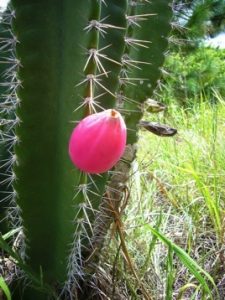
Cereus cactus fruit is wild Dragon Fruit. Photo by Green Deane
Also fruiting now are Cereus cactus. Like grapes Cereus are fairly easy to identify by genus but exactly what species is a challenge. Frankly it is a challenge one does not have to accept. Most Cereus cactus, except perhaps the commercial “Dragon Fruit” are shaped like small pink footballs about four inches long. They are attached rather strongly so nippers or the like are best to cut them off. Toss the fruit in the refrigerator for a while then cut them open like two little row boats. The white flesh has the texture of overripe watermelon. The black seeds are soft and edible (unlike most cactus seeds which are extremely hard.) The cactus themselves are called “candle” cactus as they are usually but not always an unbranching trunk. Allso called Peruvian Cactus the headache associated with species identification is there are a lot of “fake” botanical names made up by sellers. Another problem that can make cactus tough plants to identify is having to resort to counting spines and length. You can read more about them here.
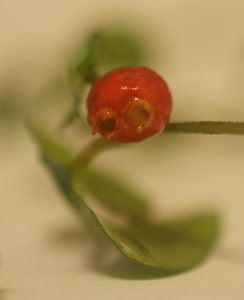
Partridgeberry has two dimples where twin blossoms were. Photo by Green Deane
Partridgeberry is not a fruit I see often in Florida and then only on the north end of the state. I usually see it in August in western North Carolina or eastern Tennessee. As one might expect the Florida Partridgeberry I’ve seen are not as robust as its kin farther north. The vine can be thinner and the leaves not as dark green. This species produces two ovaries that fuse together so one berry has two blossoms which leaves two dimples. It’s a prime identification characteristic you can see on the berry (at right.) The fruit is edible if not a bit bland. The problem is it likes to hide. It’s low growing and doesn’t mind being crowded. That said it still tries its best with a bright red fruit. The one spot in Gainesville I used to find them has been a swamp since Hurricane Irma in 2017. It clearly no longer grows there. To read more about the Partridgeberry go here.

Green Deane videos are now available on a USB.
Changing foraging videos: My nine-DVD set of 135 videos has been selling for seven years and are still available. They are the same videos I have on You Tube. Some people like to have a separate copy. A second option is a16-gig USB that has those 135 videos plus 15 more. While the videos can be run from the DVDs the videos on the USB have to be copied to your computer to play. They are MP4 files. The150-video USB is $99 and the 135-video DVD set is now $99. The DVDs will be sold until they run out then will be exclusively replaced by the USB. This is a change I’ve been trying to make for several years. So if you have been wanting the 135-video DVD set order it now as the price is reduced and the supply limited. Or you can order the USB. My headache is getting my WordPress Order page changed to reflect these changes. We’ve been working on it for several weeks. However, if you want to order now either the USB or the DVD set make a $99 “donation” using the link at the bottom of this page or here. That order form provides me with your address, the amount — $99 — tells me it is not a donation and in the note say if you want the DVD set or the USB.

Green Deane Forum
Want to identify a plant? Perhaps you’re looking for a foraging reference? You might have a UFO, an Unidentified Flowering Object, you want identified. On the Green Deane Forum we — including Green Deane and others from around the world — chat about foraging all year. And it’s not just about warm-weather plants or just North American flora. Many nations share common weeds so there’s a lot to talk. There’s also more than weeds. The reference section has information for foraging around the world. There are also articles on food preservation, and forgotten skills from making bows to fermenting food.
This is weekly newsletter #427, If you want to subscribe to this free newsletter you can find the sign-up form in the menu at the top of the page.
To donate to the Green Deane Newsletter click here.

